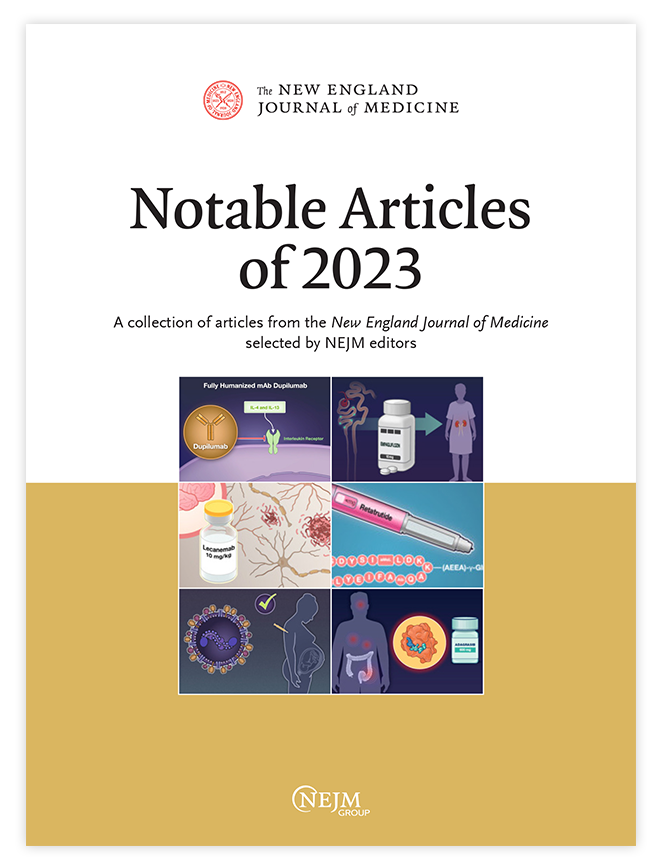Atidarsagene autotemcell治疗偏色差性脑白质营养不良的远期疗效。
IF 96.2
1区 医学
Q1 MEDICINE, GENERAL & INTERNAL
引用次数: 0
摘要
背景:异色性脑白质营养不良(MLD)是一种罕见的、严重的溶酶体贮积症,由芳基磺化酶a (ARSA)缺乏引起。方法:在两项前瞻性开放标签临床研究和扩大准入项目中,我们使用基于造血干细胞的基因疗法atidarsagene autotemcell (arsa- cell)治疗MLD患者。我们将他们的结果与未治疗的患者进行比较(自然史队列)。主要终点是无严重运动障碍的生存期(从出生到首次出现运动能力丧失和无支撑坐着或因任何原因死亡的时间)。结果共纳入治疗组39例,未治疗组49例。中位随访时间为6.76年(范围0.64 ~ 12.19年)。在症状前晚期婴儿MLD患者、症状前早期少年MLD患者(P = 0.04)和症状早期少年MLD患者(P<0.001)中,Arsa-cel导致严重运动障碍或死亡的风险显著低于未治疗的患者(P<0.001)。在未接受治疗的婴儿晚期MLD患者中,6岁时无严重运动障碍存活的患者估计百分比为0%(95%可信区间[CI],不可评估),而在接受治疗的症状前婴儿晚期MLD患者中,存活百分比为100% (95% CI, 100至100)。在未接受治疗的早期幼年MLD患者中,10岁时无严重运动障碍存活的患者估计百分比为11.2% (95% CI, 0.9至36.4),而在症状前和早期症状早期幼年MLD患者中,接受治疗的患者分别为87.5% (95% CI, 38.7至98.1)和80.0% (95% CI, 40.9至94.6)。未发现插入性肿瘤发生的证据。最常见的3级或以上不良事件是发热性中性粒细胞减少症。39例患者中有6例(15%)短暂检测到抗arsa抗体。发生了3例死亡,调查人员认为所有这些死亡都与arsa-cel无关。结论:在症状前的婴儿晚期或少年早期MLD患者和早期症状的少年早期MLD患者中,接受arsa-cel治疗的患者发生严重运动障碍或死亡的风险显著低于未接受治疗的自然病史队列患者。(由Orchard Therapeutics和其他公司资助;ClinicalTrials.gov号码NCT01560182和NCT03392987)。本文章由计算机程序翻译,如有差异,请以英文原文为准。
Long-Term Effects of Atidarsagene Autotemcel for Metachromatic Leukodystrophy.
BACKGROUND
Metachromatic leukodystrophy (MLD) is an ultrarare, severe lysosomal storage disorder caused by a deficiency of arylsulfatase A (ARSA).
METHODS
We treated patients who had MLD with atidarsagene autotemcel (arsa-cel), a hematopoietic stem-cell-based gene therapy, in two prospective open-label clinical studies and expanded-access programs. We compared their outcomes with those of untreated patients (natural history cohort). The primary end point was survival free from severe motor impairment (the time from birth to the first occurrence of loss of locomotion and of sitting without support or death from any cause).
RESULTS
A total of 39 treated patients and 49 untreated patients were included. The median follow-up was 6.76 years (range, 0.64 to 12.19). Arsa-cel resulted in a significantly lower risk of severe motor impairment or death than no treatment among patients with presymptomatic late-infantile MLD (P<0.001), those with presymptomatic early-juvenile MLD (P = 0.04), and those with early-symptomatic early-juvenile MLD (P<0.001). The estimated percentage of patients surviving without severe motor impairment at 6 years of age was 0% (95% confidence interval [CI], not evaluable) among untreated patients with late-infantile MLD and 100% (95% CI, 100 to 100) among treated patients with presymptomatic late-infantile MLD. The estimated percentage of patients surviving without severe motor impairment at 10 years of age was 11.2% (95% CI, 0.9 to 36.4) among untreated patients with early-juvenile MLD and 87.5% (95% CI, 38.7 to 98.1) and 80.0% (95% CI, 40.9 to 94.6) among treated patients with presymptomatic and early-symptomatic early-juvenile MLD, respectively. No evidence of insertional oncogenesis was found. The most common grade 3 or higher adverse event was febrile neutropenia. Anti-ARSA antibodies were detected transiently in 6 of 39 patients (15%). Three deaths occurred, all of which were considered by the investigators to be unrelated to arsa-cel.
CONCLUSIONS
Among patients with presymptomatic late-infantile or early-juvenile MLD and those with early-symptomatic early-juvenile MLD, the risk of severe motor impairment or death was significantly lower among those who received treatment with arsa-cel than in a natural history cohort that did not receive treatment. (Funded by Orchard Therapeutics and others; ClinicalTrials.gov numbers, NCT01560182 and NCT03392987.).
求助全文
通过发布文献求助,成功后即可免费获取论文全文。
去求助
来源期刊

New England Journal of Medicine
医学-医学:内科
CiteScore
145.40
自引率
0.60%
发文量
1839
审稿时长
1 months
期刊介绍:
The New England Journal of Medicine (NEJM) stands as the foremost medical journal and website worldwide. With an impressive history spanning over two centuries, NEJM boasts a consistent publication of superb, peer-reviewed research and engaging clinical content. Our primary objective revolves around delivering high-caliber information and findings at the juncture of biomedical science and clinical practice. We strive to present this knowledge in formats that are not only comprehensible but also hold practical value, effectively influencing healthcare practices and ultimately enhancing patient outcomes.
 求助内容:
求助内容: 应助结果提醒方式:
应助结果提醒方式:


